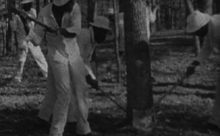Bruce Jackson's memories on his field work and making this film.
I started recording in Texas prisons in July 1964. I think Texas had about 12,000 prisoners in 14 prisons back then (they've got more than 150,000 prisoners in 105 state-run and private prisons now). My primary interest in Texas was the black convict worksongs, which seemed to me to be part of an unbroken musical tradition going back to West Africa. I was also doing life histories about crime as work and prison as community (two of the books that resulted from that are A Thief's Primer 1969 and In the Life 1972). But it was always the music and everything connected with it that interested me most.
(See Bruce Jackson's 1975 "Widelux" photos of prisoners at Cummins in Arkansas)
Black convicts in Texas mostly called them "river songs," not "worksongs." That's because all of the plantation prisons in Texas used to be located on the Brazos River or the Trinity River.
The large plantations in the U.S. South were based on West African agricultural models and, with one major difference, the black slaves used worksongs in the plantations exactly as they had used them before they had been taken prisoner and sold to the white men. The difference was this: in Africa the songs were used to time body movements and to give poetic voice to things of interest because people wanted to do their work that way; in the plantations there was added a component of survival. If a man were singled out as working too slowly, he would often be brutally punished. The songs kept everyone together, so no one could be singled out as working more slowly than everyone else.
All of that-the agricultural technology of the large plantation and the brutality of slavery-moved directly into the agricultural prisons of Texas, Louisiana, Mississippi, and other southern states. Whites never did the songs; they did not, as one black convict told me, "have the rhythm." I've described the function of the songs in the narration to Afro-American Worksongs in a Texas Prison and in notes to the Rounder album, "Wake Up Dead Man," which are available elsewhere on this site, so I won't repeat that here.
I read the Library of Congress interview (also available on Folkstreams) with Pete and Toshi about how Afro-American Worksongs in a Texas Prison got made. My memory of it differs slightly. Pete says that I suggested to him that a film be made because it was clear to me that we were at the end of a long tradition, one that would end because of integration and mechanization. It's my memory that the idea for the film came from Pete. Pete knew about the work I was doing in Texas because we'd talk about it when we saw one another at our monthly Newport Folk Festival directors and trustees meetings.
The important thing is that the film did get made, which never would have happened without Pete and Toshi. They decided it was so important for there to be a visual-aural record of this important part of African American history that they paid for it to be done and they took the time, along with their son Dan, to do the work. This is just one more debt we owe those two great people.
I said earlier that Texas had about 14 prisons in 1966, when we made this film. Since I was interested in worksongs and since that tradition was already on the wane, I concentrated on prisons for long-term convicts and multiple recidivists, prisons populated by men who had been in for a long time or who had been in several times previously. I started out on the Ramsey farm, southwest of Houston, and visited Retrieve and Sugarland which aren't far from the Ramsey. I also worked on Eastham, the Walls (the only prison in Texas with a wall around it), Wynne (at that time, a prison for physically infirm and geriatric inmates) and Ellis, all of them in or near Huntsville, which is 70 miles north of Houston.
I found the best worksong performers at Ellis, about 15 miles northeast of Huntsville, which was as close to a maxi-maxi prison Texas had in those years. That's why when Pete and Toshi said they wanted to come down to shoot the film, I said, "Meet me at Ellis." Which is what they did.
Some of the performances in the film are also on the CD, Wake Up Dead Man. That's because I'd been recording worksongs with that same group of men before Pete, Toshi and Dan came down, so I continued running my recorder while they were there and after they went back home.
One thing about the film that's always amused me: One of the verses when they're singing "Down by the Riverside" while using hoes to break up clods in a field a disker has just gone through, goes "Gonna meet Mister Bruce and Mister Pete down by the riverside..." As I recall, I didn't hear that line when they filmed and I recorded it, but Pete told me about it afterwards. "Well, you surely can't use that in the film," I said. "Of course we can," Pete said, "it's the folk process!" And so he did: listen carefully and you'll hear it.
